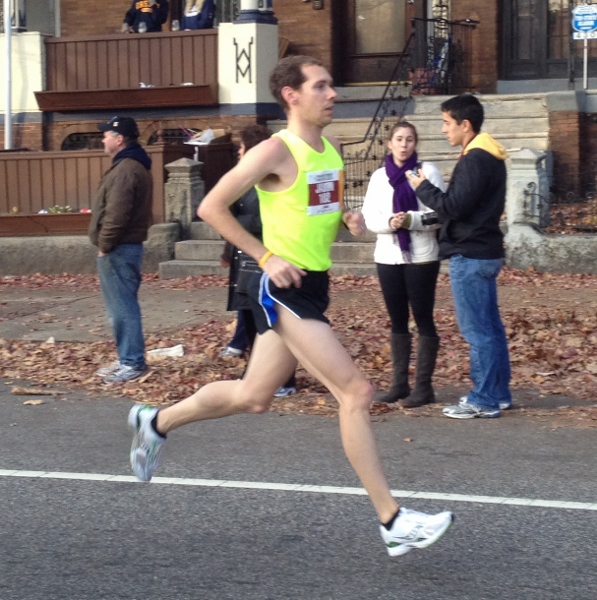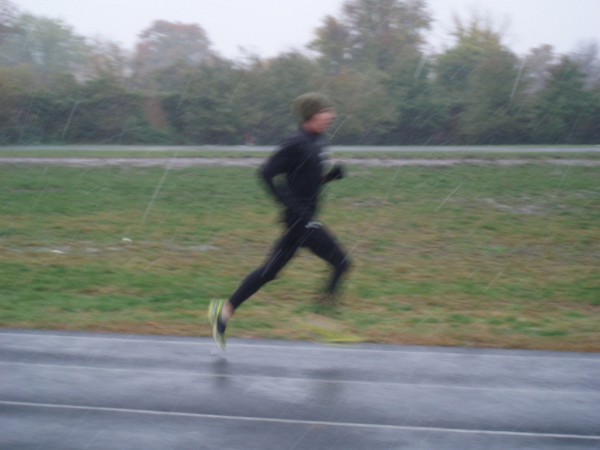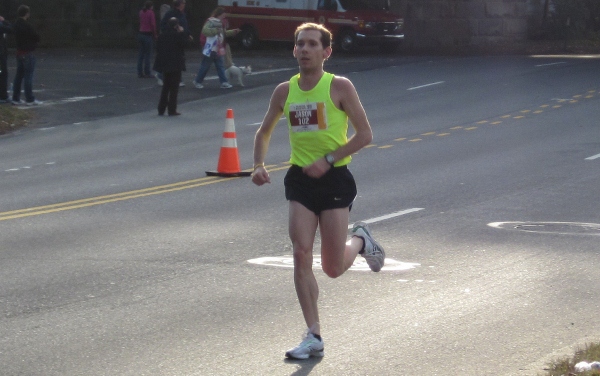On November 20th, I raced the Philadelphia Marathon and finished 42nd in a time of 2:39:32, a PR of over 5 minutes.
I never hit the wall, barely slowed down at all during the last 6.2 miles, and felt strong from start to finish. The Philly Marathon is my crowning achievement in my 13+ years as a distance runner.

I made the decision to run another marathon with trepidation; my last marathon was over three years ago at New York. I ran 2:44:38 and was sidelined by severe illiotibial band syndrome for six months afterward. I was mentally crushed and doubted that I’d ever run another marathon. I even considered permanent retirement.
In hindsight, that injury was one of the best things to ever happen to me as a runner. It forced me to reevaluate my training and learn what really works. I devoured every running book and training website I could find. I learned everything I could about how to train effectively to run fast and prevent injuries.
It worked: I’ve been injury-free since 2008 and I just took five minutes off my marathon time, getting under that elusive 2:40 barrier.
More importantly, the injury and my study of running prompted me to start Strength Running. After seeing so many runners making the same mistakes that I used to make, I wanted to help as many people as possible become better runners. Thank you to all the runners who’ve supported this site – through sharing an article, buying a race plan, or commenting on a post. I appreciate it all.
Now that you know the background of my hesitation to run another marathon, let’s dig into the details…
How Do You Train for a 5+ Minute PR?

My training for Philly started in early August and spanned 17 weeks of specific marathon preparation. I focused on the basics: high mileage, lots of marathon pace running, long runs specific to the marathon, and maintenance work.
Maintenance work is the running that makes goal pace easier: strides, shorter fartleks, tempo runs, hills prints, and a small amount of Vo2 Max intervals. I try to never get too far away from one type of training, so while my focus for the marathon was on aerobic development and marathon pace, I didn’t ignore the other aspects of sound training.
My overall mileage for most of this training phase was in the 80-85 range, with a few weeks higher and lower. I averaged about 10 miles more per week than my training for New York so I knew that I was stronger and more prepared. My monthly mileage:
- August: 311 (Monthly Report)
- September: 342 (Monthly Report)
- October: 345 (Monthly Report)
Unlike my previous marathon training, I used a lot of double runs during this cycle – peaking at a double of 11 miles in the morning and 7 miles in the afternoon. Doubles take a few weeks to get used to so don’t feel discouraged if you don’t feel good right away. It also took me weeks to get used to this volume when I’ve historically done 10 and 5 mile doubles.
One workout helped prove that my fitness was where it needed to be: my last long run of 22 miles. Instead of just easy mileage, I ran a moderate 6:59 pace for the first 11 miles and then ran 3 x 3miles during the last 11 miles with a mile of recovery running. The splits for each faster segment were 18:46, 18:05, and 17:46. Even the recovery miles were fast – both were under 6:40.
Training Secrets and Magic Workouts!
For top marathon secrets of fast marathoners, just send three easy payments of $19.95! Limited time only!
Look: there are no training secrets. No one workout will make you a good marathoner. The boring truth is that continued improvement in the marathon is fairly simple (but not easy): run a lot, run fast sometimes, and stay healthy.
Do this for months and years and you’ll get damn fast. But this strategy is admittedly boring – there aren’t any silver bullet workouts or training philosophies that are going to transform your running overnight. There are good ways to do things and best practices (that’s where I can help), but don’t expect any miracles with a low mileage, short training cycle.
As Mark Wetmore, head coach of the University of Colorado Cross Country team has said:
We don’t have any secret weapons…the cornerstone [of our program] is the long-term, patient development of the aerobic metabolism.
One way that I can help you run a fast marathon is through our comprehensive training programs for runners. Almost all of them include training plans that can be used for the marathon!
Philadelphia Marathon Race Execution
 About mile 23. Not the best form here – can you tell I’m exhausted?
About mile 23. Not the best form here – can you tell I’m exhausted?
Since I felt so horrible during my last marathon, I was nervous at the start. A million questions ran through my head on race morning:
- What if I hit the wall again?
- What if my IT Band acted up?
- What if I needed to use the bathroom in the middle of the race?
- What would happen if I ran slower than my other marathon?
- What if my Gu packets fell out of my pocket?
- What if I went the wrong way…?
I was being unreasonably nervous. I think this is normal, though. As Alberto Salazar has said: “I had as many doubts as everyone else. Standing on the starting line, we’re all cowards.”
I ran 6:03.9 mile pace for the first 20 miles – exactly according to plan. When I hit the 20 mile mark in Manayunk at the end of the Kelley Drive stretch, I felt surprisingly good. So good that I ran 6:01 for my 22nd mile! That would be my last “fast” mile of the race but I still pushed the effort until the finish line. There was no hitting the wall.
My strategy for avoiding that seemingly inevitable bonk was twofold: adequate training (check!) and a lot of carbo-loading. Starting on Wednesday before the race, I started eating a lot more carbs than normal. I didn’t feel good sometimes with the fluctuations in blood sugar, but cramming glycogen into my muscles and liver was more important.
I also took 6 gels and a cup of Gatorade during the race, amounting to over 160g of carbs. To put this in perspective, that’s more carbs than an entire pint of Ben & Jerry’s. This is on top of my breakfast of oatmeal, a Powerbar Harvest, a banana, and (obviously) two cups of coffee.
The marathon isn’t just physical; the mental aspect of a good race can’t be overlooked. From the start, my mentality was to remain calm and just relax. I want to credit Greg Strosaker for giving me the idea to use the mantra of “relax” – it worked for him when he won his last marathon in a 2:56 PR and it worked for me. Thanks Greg!
Sometimes “no news is good news” and in this case, it’s an appropriate saying. Nothing significant happened during the race – just the slow ticking off of fairly consistent splits. Here are most of them:
Mile 1: 5:55
Mile 2: —
Miles 2/3: 11:51
Mile 4: 6:05
Mile 5: 6:00 –> 29:52 at 5 miles
Miles 6/7: 12:05
Mile 8: 6:13
Mile 9: 6:10
Mile 10: 6:13 –> 60:35 through 10 miles
Mile 11: 5:48
Mile 12: 6:00
Mile 13: 6:04
Half Split: 1:18:28
Mile 14: 6:03
Mile 15: 6:07 –> 1:30:39 through 15 miles
Mile 16: 6:04
Mile 17: 6:05
Mile 18: 6:09
Mile 19: 6:04
Mile 20: 6:12 –> 2:01:16 through 20 miles
Mile 21: 6:08
Mile 22: 6:01
Mile 23: 6:15
Mile 24: 6:13
Mile 25: 6:13
Mile 26.2: 7:25 –> 6:10 pace
After Philly: What’s Next
Sloth? Gluttony? For now.
But long-term, I’ll probably train for the 5k in the late winter and spring. I may even do a Warrior Dash if it fits into my schedule.
Now that I have a qualifying time for Boston for the highest registration wave, I’d like to run Boston in 2013. What marathoner doesn’t want to eventually run the Boston Marathon?
Until then, I’ll be recovering with two weeks of no running, plenty of sleep, and maybe a few beers. I spoil myself.